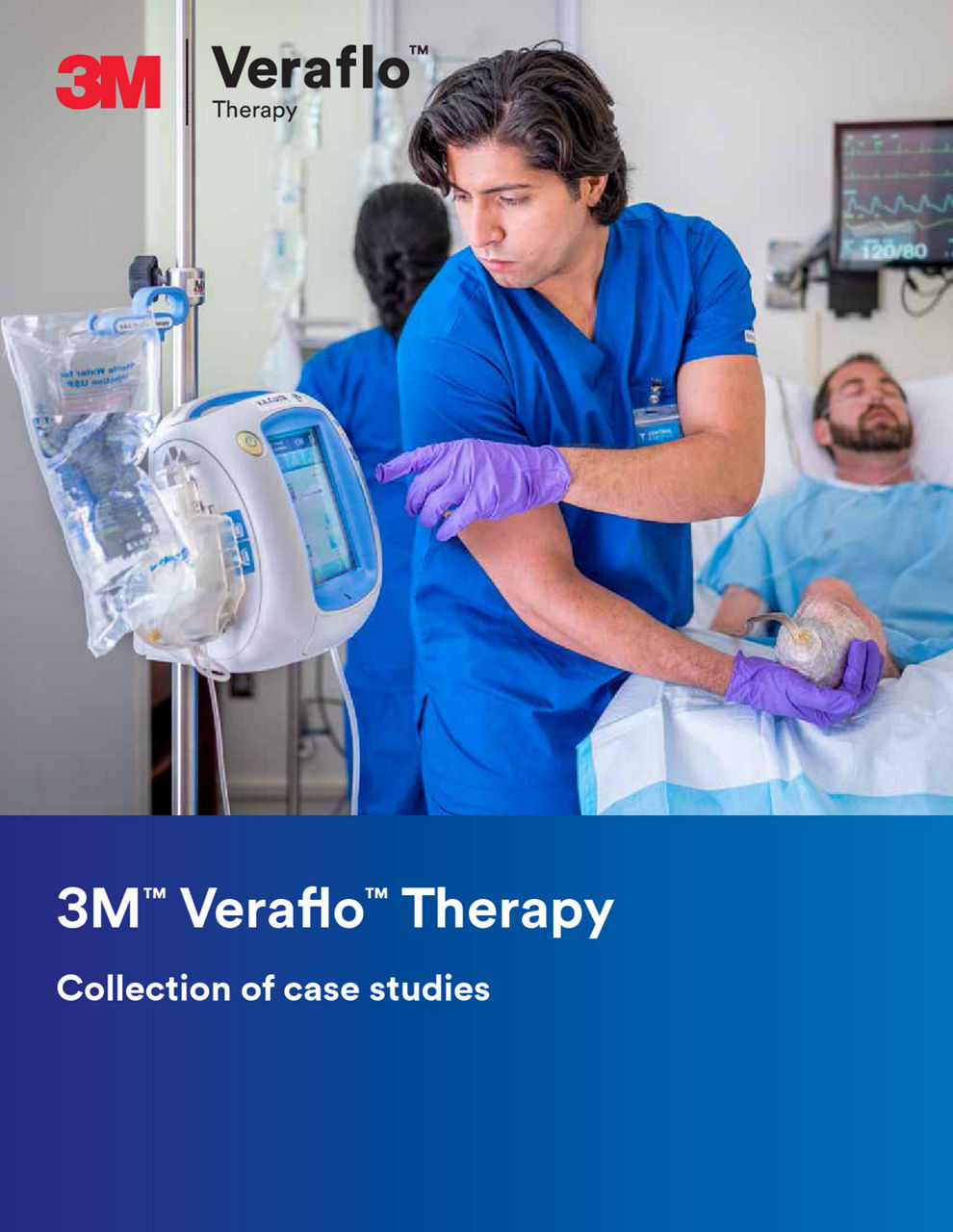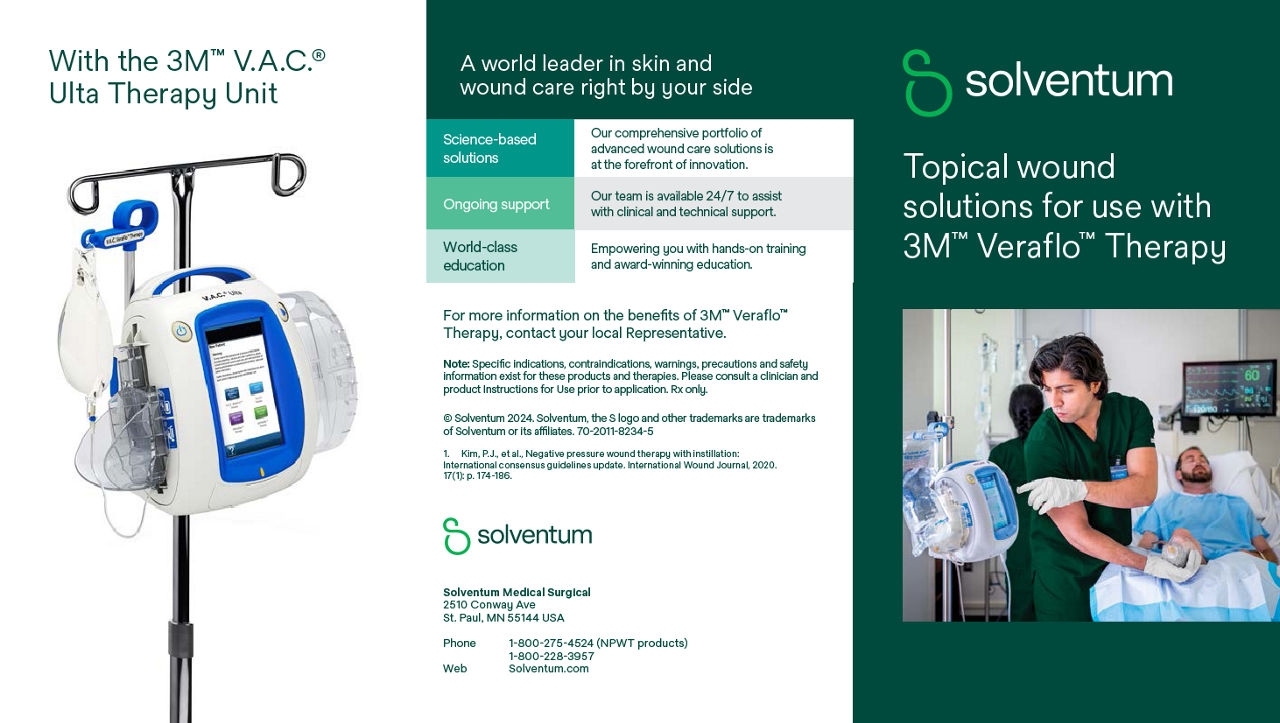3M Veraflo Therapy
Managing bioburden in the wound treatment plan
Forty percent of all wounds are infected or critically colonized.1 As a result, wounds may be susceptible to contamination or the development of bioburden – key contributors to complications like infection, inflammation and delayed healing. Therefore, early intervention is important to help create a wound healing environment, minimize wound complications and help provide positive outcomes.
3M™ Veraflo™ Therapy can be part of the treatment plan for infected wounds, in conjunction with good clinical practice such as debridement and antibiotic therapy. Veraflo Therapy allows the instillation of topical wound solutions that can help manage the bacterial population through repeated cleansing cycles, thus, interrupting the bioburden lifecycle. Reduction of bacterial bioburden with the use of Veraflo Therapy has been reported to positively impact the wound healing process.2,3
How Veraflo Therapy works
Veraflo Therapy provides automated topical wound solution instillation, dwell and removal to repetitively cleanse wounds while providing the benefits of negative pressure wound therapy. It facilitates the removal of wound exudate and infectious material.

Three successive applications - dressing change every 3 days Veraflo therapy applied with saline instillation and Veraflo™ Cleanse Choice™ Dressing.5
Images displayed: A) Before Veraflo Therapy, Day 0 B) After Veraflo Therapy, Day 9
Veraflo Therapy can help:
Achieve positive clinical outcomes
Veraflo Therapy has demonstrated positive clinical outcomes, when compared to standard care including traditional NPWT.8 In a systematic review of comparative studies and meta-analysis,8 the performance of Veraflo Therapy was evaluated in 13 studies involving 720 patients, with various wound types. Veraflo Therapy was shown to deliver significant advantages over standard of care, including improved wound management.
- >30% fewer surgical debridements8,9 (1.77 debridement's vs 2.69, p=0.008)
- Wounds were 2.39 times more likely to close8 (p=0.01)
- >50% reduced length of therapy8,9 (9.88 days vs 21.8 days, p=0.02)
- Reduced bacterial count from baseline8 (Odds were 4.4 times greater p=0.003)
- Ready for closure almost twice as fast8,9 (7.88 days vs 14.36 days, p=0.003)
- Study limitations, including high patient and wound population heterogeneity across studies, require cautious interpretation of the results.
Use of Veraflo Therapy can potentially reduce costs versus standard of care9
This economic model analyzed the potential cost savings of using 3M™ Veraflo™ Therapy based upon the findings of the Gabriel et al. meta-analysis.9

Understanding Veraflo Therapy
Resources
Veraflo Therapy components
The first and only clinically evaluated therapy that provides hydromechanical removal of non-viable tissue. Veraflo Therapy with Veraflo Cleanse Choice Complete Dressing or V.A.C. Veraflo Cleanse Choice Dressing provides a therapy that can reduce the number of required surgical debridements and prepare the wound for closure faster.

Additional Veraflo Therapy components
Explore a range of accessories for use with Veraflo Therapy. These accessories are designed to create an environment that promotes wound healing and improves patient outcomes.
Veraflo Therapy: How-to videos
Explore more
References:
- September 2014 Survey, N = 240, Surgeons, Podiatrists, WOCNs and PT.
- Gabriel A. Integrated negative pressure wound therapy system with volumetric automated fluid instillation in wounds at risk for compromised healing. Int Wound J. 2012; 9 Suppl 1:25-31.
- Wolvos TA, Negative pressure wound therapy with instillation: the current state of the art, Surgical Technology International. 2014; 24:53-62.
- Zhan C, Miller MR. Excess Length of Stay, Charges, and Mortality Attributable to Medical Injuries During Hospitalization. JAMA. 2003; 290(14): 1868-74.
- Teot L, Boissiere F, Fluieraru S. Novel foam dressing using negative pressure wound therapy with instillation to remove thick exudate. Int Wound J. 2017;14(5):842-848.
- Brinkert D, Mazen A, Naud M, Maire N, Trial C, Teot L. Negative pressure wound therapy with saline instillation: 131 patient case series. Int Wound J. 2013;10 Suppl 1:56-60.
- Gupta S, Gabriel A, Lantis J, Teot L. Clinical recommendations and practical guide for negative pressure wound therapy with instillation. Int Wound J. 2016;13(2):159-174.
- Gabriel A, Camardo M, O’Rorke E, Gold R, Kim PJ. Effects of Negative-Pressure Wound Therapy With Instillation versus Standard of Care in Multiple Wound Types: Systematic Literature Review and Meta-Analysis. Plast Reconstr Surg. 2021 ;147(1S-1):68S-76S.
- Kim PJ, Lookess S, Bongards C, Griffin LP, Gabriel A. Economic model to estimate cost of negative pressure wound therapy with instillation vs control therapies for hospitalised patients in the United States, Germany, and United Kingdom. Int Wound J. 2021;1–7.
- Ref 3M™ V.A.C.® Ulta Negative Pressure Wound Therapy System Safety Information and 3M™ V.A.C. Veraflo Cleanse Choice™ Dressing System Application Instructions.
















